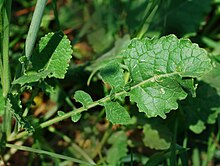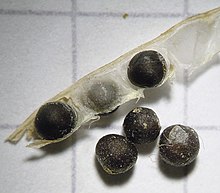Mustard
| Mustard | ||||||||||||
|---|---|---|---|---|---|---|---|---|---|---|---|---|

White mustard ( Sinapis alba ), illustration |
||||||||||||
| Systematics | ||||||||||||
|
||||||||||||
| Scientific name | ||||||||||||
| Sinapis | ||||||||||||
| L. |
Mustards ( Sinapis ) are a small genus of plants in the cruciferous family (Brassicaceae). The White mustard ( Sinapis alba L.) is an important crop .
description




Vegetative characteristics
Sinapis species are mostly annual, rarely perennial, herbaceous plants that reach heights of 30 to 80 centimeters. The above-ground parts of the plant can be bare or hairy with simple trichomes . The upright stem can be branched at the top.
The alternate and spirally arranged leaves on the stem are stalked or sessile and simple or compound. The lower leaves are usually stalked and the leaf blade is rarely easy, but usually highly indented , fiederspaltig, lyre-shaped to once or twice pinnate . The upper leaves have shorter to hardly recognizable stems, whereby they do not include the stem at the base and the leaf blade is more or less simple, at most slightly lobed. The leaf margin is unevenly more or less serrated.
Inflorescence and flowers
The flowers are in a terminal, initially umbrella- clustered , by an inflorescence axis that is considerably elongated to fruit ripe, later clustered inflorescence .
The hermaphrodite, four-fold flowers of the Sinapis species have the typical cruciform structure of the cruciferous vegetables with four-fold, double flower cover . The four green, free sepals are narrowly elongated to linear and mostly spread out, rarely bent back. The four yellow, free petals are nailed, obovate and spread out. There are six free, fertile stamens with elongated anthers. Two carpels have become a top permanent ovary grown, the four to twenty ovules contains. The style ends in a cephalic or bilobed scar. There are four nectar glands that are not fused with each other, the side pair being prismatic and flat, but the middle pair being ovoid.

Infructescence, fruits and seeds
The fruit stand is strongly loosened. The slender to often thickened fruit stalks are upright, ascending, sparse to arched back. The pods that protrude from the stem are linear, lanceolate, elongated, stem-round to approximately flattened and thus somewhat square-edged pods that split open in two lobes when ripe. The elongation of the pods by a seedless fruit beak is characteristic of the genus. The valves have three to seven raised or thin to thick and indistinct nerves. The membranous septum is fully developed. The replay is rounded. A segmented pod contains two to five, rarely twenty seeds in a row, with the last segment containing no seeds or at most two seeds.
The mostly clumsy and spherical, rarely slightly flattened seeds have a mostly fine net-like surface. In the seeds, the two cotyledons (are cotyledons ) folded longitudinally. The seeds of the mustard species are characterized by a very long germination capacity (40 years and more).
Chromosome numbers and ingredients
The basic number of chromosomes is x = rarely 7, usually 9 or 12.
The mustard oil glycosides contained in many cruciferous plants are present in high concentrations in mustard species, especially in white mustard.
Locations
In culture taken species in the world are often naturalized in many parts. The mustard species tend to run wild. Most species grow wild in open, disturbed locations such as fallow land , roadsides or field margins.


Systematics and distribution
The genus Sinapis was first published in 1753 by Carl von Linné in Species Plantarum , Volume 2, page 668. The genus Sinapis belongs to the Brassiceae tribe in the Brassicaceae family .
The four types of mustard come from the Mediterranean region , especially from northern Africa . Two of them radiate far to the Middle East .
Four species belong to the genus Sinapis :
- Field mustard ( Sinapis arvensis L. ); It is distributed with at least two subspecies in Eurasia and North Africa; but he is a neophyte worldwide.
- White mustard ( Sinapis alba L. ): The at least three subspecies are common in Europe, North Africa and from western Asia to Pakistan ; but he is a neophyte worldwide.
- Sinapis flexuosa Poir. : The home is the Canary Islands, Morocco , northern Algeria and southern Spain .
- Sinapis pubescens L .: The three subspecies occur in Algeria, Tunisia , Libya , Italy , Sicily , Albania and France .
Mustard species that do not belong to the genus mustard ( Sinapis )
Botanically not included in the genus mustard ( Sinapis ):
- Black mustard ( Brassica nigra (L.) WDJKoch )
- Brown mustard ( Brassica juncea (L.) Czern. )
- Ethiopian or Abyssinian mustard ( Brassica carinata A.Braun )
“Black”, “brown” and “white” in German trivial names refer to the color of the seeds that are used to make mustard .
swell
- Suzanne I. Warwick: Sinapis , p. 441 - the same text online as the printed work , In: Flora of North America Editorial Committee (Ed.): Flora of North America North of Mexico. Volume 7: Magnoliophyta: Salicaceae to Brassicaceae , Oxford University Press, New York and Oxford, 2010, ISBN 978-0-19-531822-7 . (Sections systematics and description)
- Tai-yien Cheo, Lianli Lu, Guang Yang, Ihsan Al-Shehbaz, Vladimir Dorofeev: Sinapis , p. 24 - online with the same text as the printed work , In: Wu Zheng-yi, Peter H. Raven (ed.): Flora of China . Volume 8: Brassicaceae through Saxifragaceae , Science Press and Missouri Botanical Garden Press, Beijing and St. Louis 2001, ISBN 0-915279-93-2 . (Sections systematics and description)
Individual evidence
- ↑ a b c d e f Sinapis in the Germplasm Resources Information Network (GRIN), USDA , ARS , National Genetic Resources Program. National Germplasm Resources Laboratory, Beltsville, Maryland.